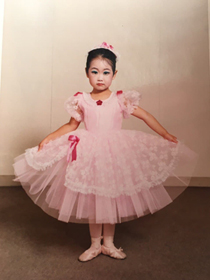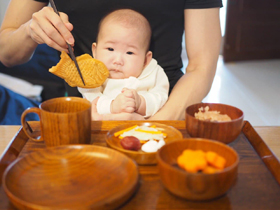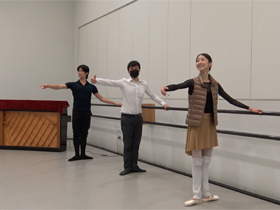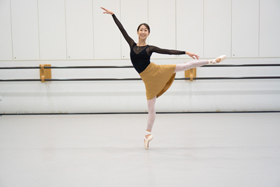

Featured Article of the Month
Dancing on in Singapore - Interview With Chihiro Uchida
|
In February, JCC interviewed Chihiro Uchida, a Principal Ballet Dancer with Singapore Dance Theatre. Originally from Tochigi Prefecture in Japan, she moved to Singapore 15 years ago and has not only established a name for herself in Singapore’s dance scene, but has also created a second home on the island.
Japan Creative Centre (JCC): When did you start ballet, and when did you move to Singapore? |
|
Chihiro Uchida (U): My mother told me as soon as I started walking, I started dancing to music. She took me to my first ballet lesson when I was two-and-a-half years old. When I was 15, I participated in the Asian Pacific International Ballet Competition in Tokyo and I received a scholarship to The Australian Ballet School in Melbourne. The scholarship made me think that maybe I could do something with dancing and gave me the hope that I could maybe be a ballerina one day. I went to The Australian Ballet School and studied there for three years.
I came to Singapore in 2005 and did my audition with Singapore Dance Theatre and they offered me a job. This is where my career started and I’m really happy and glad that I came here. |
 © Chihiro Uchida |
|
JCC: Are there any aspects of Singapore lifestyle and culture that you like? And do you feel like Singaporeans are in love with Japan?
U: Actually, I was amazed to see people from so many different countries, religions, and races living in such good harmony in Singapore. They have their own festivities and traditions, but I see them celebrating as one people and I think that it’s very unique. I always loved seeing that. Yes, I am surprised to see many Singaporeans buying groceries at Don Don Donki (Japanese chain store that is known as ‘Don Quijote’ in Japan). I’ve been living here for 15 years and Japanese food is a lot more accessible in Singapore now. I see more and more Don Don Donki outlets in Singapore, which means that a lot of people are shopping there. I am really happy that Singaporeans are enjoying Japanese food here. JCC: Have you noticed any cultural differences between Japan and Singapore? U: Yes, I find Japanese people like to hide their emotions, whereas Singaporeans are less afraid to voice out their opinions. I think that’s quite good, and I’m learning. When I first came here and made Singaporean friends, something that shocked me was that they were very honest about their feelings. I thought it was very direct but then later I thought sometimes it is better to tell people how you really think or feel about the situation. I started to get used to that and I think it was a good influence for me. JCC: Do you celebrate any Japanese holidays or festivals here in Singapore? Do you introduce such holidays to your non-Japanese colleagues and friends? U: Yes, my husband and I enjoyed celebrating my daughter’s okuizome (お食い初め) last year. Okuizome is a “first meal” ceremony for babies for their first 100 days of their life. I prepared some ceremonial food and my husband pretended to feed her with the hope that she would never have to worry about food in the future. I really find that tradition special and I also shared this experience on social media to show my friends and people around me. There were some comments saying that it’s such a nice tradition and some of them also commented with good wishes, such as wishing that she grows up in Singapore healthy and well. |
|
For okuizome, we usually prepare sea breams as one of the dishes but I was not able to find it in supermarkets so instead of raw fish, I bought taiyaki. Taiyaki is a Japanese dessert with sweet red bean paste inside a wafer in the shape of a sea bream. I put it on the plate and told my daughter, “Sorry it’s not a real sea bream but I hope you will grow up with good health and you will eventually have a good appetite.”
JCC: Culturally, have you learnt anything from Singapore and Singaporeans? |
 © Chihiro Uchida |
|
U: Yes, I have no problem ordering food at hawker centres in Singapore. I can order teh and kopi peng for my husband. (laughs) SDT was at Fort Canning Park before moving to this studio in Bugis+. Whenever I took a taxi from home, I would tell the uncle “Can you bring me to Fort Canning Park?” and the uncle would be confused. It turns out Singaporeans say it differently. I tried to say it the same way after that and we could communicate better. I found it unique and funny.
JCC: Do you think you have any habits that were influenced by your Japanese upbringing? Were there things that you didn’t know were so Japanese until you came here? U: I feel like Japanese people, including myself, apologise a lot. Maybe we do it a little bit too much, but maybe it’s part of Japanese culture and how we grew up. We want to be polite and humble. Also, we have another word, ‘sumimasen,’ which directly translated means “excuse me,” but we use it to mean “sorry.” ‘Gomennasai,’ as well. Maybe that’s why we apologise a lot. Even celebrities apologise on TV a lot and I found that it’s a very unique thing that I don’t see happening in other countries very much. JCC: Tell us about education and outreach programmes you have participated in Singapore. U: Before COVID-19, SDT used to visit local schools to introduce ballet to students. We taught them the history of ballet, dancers’ daily routines, and performed some classical and contemporary pieces to teach them how different they are. Whenever we demonstrate something like a male dancer lifting a female dancer overhead, the students will go “wow!”. I always enjoy seeing their pure reactions. |
|
Other than that, we do a monthly in-studio showing called “One @ the Ballet”. One @ the Ballet is a part-narrative part-dance presentation in the SDT studios. It is for public audiences and is held once a month on Saturdays. I think the highlight of this programme is that the audience can learn details of ballet from our Artistic Director and watch dancers perform right in front of them. I think it’s a great opportunity for the audience to know more about us.
I also teach students who are in SDT’s Scholars Programme. This is a programme under SDT where aspiring dancers can learn ballet from professional teachers as well as our Artistic Director. I enjoy teaching them. |
 |
|
JCC: How does Japanese ballet scene compare to Singapore? Do you feel a change in the past 15 years?
U: Ballet is more popular in Japan partly because Japan has a bigger population and there are more schools and ballet companies there, but I think Singapore’s art scene is getting more vibrant. I think audiences are becoming more appreciative as well. It’s such a difficult time for the art scene at the moment but many people have reached out to show their care and support to SDT and I’m very thankful for that. Some of the ex-dancers from SDT have also opened their own ballet studios in Singapore and I see more and more Singaporeans, especially young Singaporeans, getting into ballet and participating in ballet competitions. More young dancers are pursuing careers in dance, so once the COVID situation improves, things are going to get better. I think both Japanese and Singaporean students are very focused and very hardworking. If they work hard, it makes me want to work hard for them too, so it is a good thing for both sides. JCC: What are your favourite local food and drinks, and what kind of dishes do you find the most irresistible? U: I love nasi padang very much, especially beef rendang and sambal belacan. These dishes make me the happiest person in the world. If I had a good teh tarik, that completes everything. I have several favourite places in mind, the nearest one is near my house. They know me already so before I even have to ask, they would prepare beef rendang for me. There is another one near Bugis; my colleague told me about it when I was pregnant because I was craving Malay food so much. I enjoyed it very much and my baby liked it too! (laughs) I also like curry chicken, durians, chicken rice, chee cheong fan…! (laughs) JCC: You met your partner here in Singapore; can you tell us about your favourite dating places? U: We like to do touristy things like going to Sentosa and Mount Faber Park. We’ve taken cable car rides and the Singapore River cruise to see the Merlion splashing water from the other angle. We also go to Geylang to eat durians and cycle at East Coast Park. Yes, we do like durians! Mao Shan Wang, that’s my favourite! (laughs) After having my daughter, we like to go for walks around my neighbourhood. |
|
JCC: Do you find that your daughter’s childhood in Singapore is different from yours in Japan, and would you want her to stay and grow up here?
U: Yes, I grew up in the countryside near the mountains and rivers chasing grasshoppers, but my daughter is totally a city girl. Her childhood and my childhood are very different. She already started to go to school at such a young age, and I think my daughter will have a good education, growing up in Singapore. I like that my daughter enjoys the city life but I also want her to spend time with my grandparents as well because I loved spending time with my grandparents when I was young. I wish she could do the same. |
 |
|
JCC: How old is your daughter and has she picked up any other languages besides Japanese?
U: Yes, so far, she has picked up some English words. She also prefers to say some English words instead of Japanese, such as ‘shoe’ instead of ‘kutsu’ in Japanese. I think if she didn’t live in Singapore, she wouldn’t be able to pick up English words this early. I’m very happy about that. She’s a year and three months old but because her teachers are Singaporeans, I’m sure she will pick up some other interesting Singlish in the future and I’m really excited to see what’s next. If I’m not wrong, the other day she might have said “aiyoh” or something like that. (laughs) JCC: Can you tell us about your neighbourhood – what kind of area is it, and what’s interesting in it? U: I stay in central area, where there are mixture of offices and quiet areas. It is really convenient to find shops, schools, and parks nearby around our neighbourhood. I like to walk around our neighbourhood with my family to find hidden green spaces in between buildings and offices. We see many familiar faces on our evening walks. We usually walk pass people doing taichi, with my daughter on the tricycle alongside us, and if we see someone we know, we greet them. I’m very happy that my daughter can wave at them as well. I enjoy interacting with the local people. Actually, just yesterday, one of them told my daughter, “Oh, you grew up so much! I remember you were so little before!” and I found it very sweet. JCC: What is Singapore to you? |
|
U: I left Japan when I was 16 and I have been living in Singapore for 15 years, so basically, I have been living here as long as I have lived in Japan. I do feel at home in Singapore. If I didn’t feel at home, I think I wouldn’t have stayed here for this long. I feel very comfortable living in Singapore surrounded with so many good things and good food.
If I had to go back to Japan one day, I would miss the food, the weather, and of course Singapore Dance Theatre. Watch the interview here. |
 |
* All photos used in this article are taken by JCC / © JCC unless otherwise stated
|
Japan Creative Centre 4 Nassim Road, Singapore 258372 +65 6737 0434 / jcc@sn.mofa.go.jp https://www.sg.emb-japan.go.jp/JCC/ Nearest parking at Orchard Hotel & Delphi Orchard |
 |